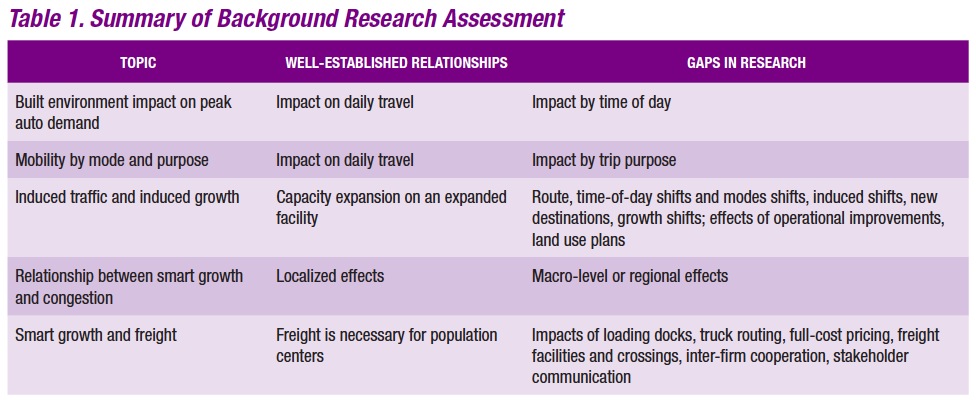STRATEGIC HIGHWAY RESEARCH PROGRAM
TRANSPORTATION RESEARCH BOARD
Smart growth generally refers to characteristics of the urban form and built environment that are associated with benefits to environmental protection, public health, and quality of life, as well as economic and social benefits. One of the more established benefits of smart growth is reduced travel and the resulting decrease in congestion and delay, along with their costs to businesses and households. Other benefits include reduced infrastructure expansion, energy consumption, and greenhouse gas and other emissions.
While the transportation-land use connection and the impact of various smart growth strategies on travel demand are well-documented, practical guidance and tools for interpreting these insights to make them useful at key project decision points have been lacking. The objective of SHRP 2 Capacity project C16 was to provide transportation planning agencies with improved tools and methods for more accurately and comprehensively integrating transportation investment decision-making with land development and growth management.
The project produced two products to improve communication, interaction, and partnerships between decision-makers and planners in both the transportation and land use arenas:
- A decision support software tool for regional and local planners to test smart growth scenarios and evaluate their impact on travel demand, and
- On-line resources to understand the dynamics and inter-relationships of smart growth strategies with the performance of a transportation investment as background and supplement to the software tool.
These resources can bridge the gap between regional planning visioning exercises and transportation plans in relation to the evaluation of smart growth strategies. This will allow state, regional, and local agencies to evaluate smart growth strategies quickly and easily so that promising smart growth strategies can be identified and pursued in the land use and transportation planning processes. This can also supplement more sophisticated modeling efforts, which can be used to evaluate specific smart growth projects.
The Products
The project produced a synthesis of the extensive research available and a software tool (Smart- GAP) that can be used to evaluate the impact of smart growth policies on travel demand. The tools were pilot tested by Maryland Department of Transportation, Atlanta (Georgia) Regional Council, and Thurston (Washington) Regional Planning Council.
The research identified well-established relationships between smart growth strategies and various impacts for five topic areas that would be valuable in the evaluation of smart growth strategies. In addition, gaps in the existing research were identified because they represent useful capabilities in the SmartGAP software, although not all gaps could be filled in the initial version. Table 1 identifies the relationships and gaps.
SmartGAP Planning Tool
SmartGAP evaluates regional scenarios based on changes in the built environment, travel demand, transportation supply, and transportation policies being considered.
It is a robust statistical package that tracks the characteristics of individual households and firms in a region and determines the travel demand from these characteristics. This tool was designed to address as many of the limitations identified in the research as possible and to fill a gap in the set of available tools.
Currently, SmartGAP can provide information on the following changes in the regional system:
Built Environment–changes to the urban form (e.g., proportion of population and employment living in mixed use areas, transit oriented developments, or rural/greenfield areas)
Travel Demand–changes in population demographics (age structure), changes in personal income, changes in firms by size or industry, relative amounts of development occurring in urban core, close-in communities, suburban or rural areas, population and employment densities, auto and light truck proportions by year, induced demand – short term impacts
Transportation Supply–amounts of regional transit service, amounts of freeway and arterial capacity
Policies–pricing (vehicle miles traveled charges or parking pricing programs), ITS strategies for freeways and arterials, demand management (vanpool, telecommuting, ridesharing, and transit pass programs)
SmartGAP evaluates a series of performance metrics resulting from smart growth scenarios: community impacts, travel impacts, environmental and energy impacts, financial and economic impacts, and location impacts. These provide a rich assessment of each scenario at a regional scale and SmartGAP is flexible in how the place types are applied in each region. All of the input data can be developed from available data sources, which are provided with the application. If a regional agency has local data, they can be used in place of the data in the system. To allow for wide distribution, the software was developed using “R,” an open-source statistical package.
SmartGAP is designed to be easy to setup and use, so smaller planning agencies with fewer staff resources can make use of it. Larger planning agencies can take advantage of the processing speed and relative ease of use to run multiple scenarios for screening purposes before more complex and time-consuming integrated land use and travel demand forecasting models are needed.
Download full version (PDF): Evaluating the Effect of Smart Growth Policies on Travel Demand
About the Strategic Highway Research Program
www.trb.org/StrategicHighwayResearchProgram2SHRP2/General.aspx
“SHRP 2 will focus on applied research in the following areas, which were identified by experts who began planning for the program in 1999. The focus areas were selected on the basis of their importance to the nation’s economic system and quality of life and because strategically targeted research in these areas promises to yield high payoffs.”
About the Transportation Research Board
www.trb.org
“The mission of the Transportation Research Board is to provide leadership in transportation innovation and progress through research and information exchange, conducted within a setting that is objective, interdisciplinary, and multimodal.”
Tags: SHRP2, Strategic Highway Research Program, Transportation Research Board, TRB, TRB of NA







 RSS Feed
RSS Feed